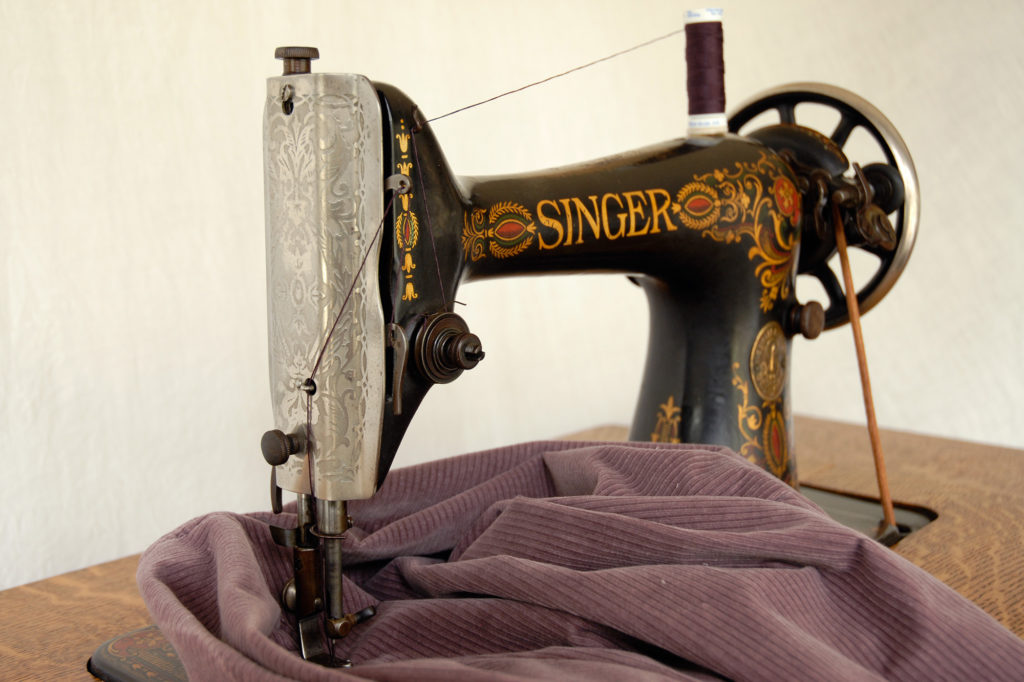There are many benefits to having an older machine, but there are also things you need to keep in mind before purchasing. I will be focusing this article on machines 60 to 70 years old made around the 1950’s.
Classic appearance: Most of these great machines were black or came in other neutral colors such as white or tan. Their simple curves and bare exterior make it appealing to a wide range of styles.
- Look for a machine that has most if not all it’s enamel or coating intact.
- Make sure there’s a pressure foot and power cord, but also look at the housing for the light fixture and check for any missing parts. (These tend to be a little spendy if they need to be replaced.)
- Try to inspect any exposed wires. Look for cracks, melted coating or unusual wear. Wiring can be replaced for a moderate cost and should not deter you from buying a machine. Just be sure to replace any bad wiring before sewing with the machine!

Solid metal construction: Good machines will have very little or no plastic parts. You will not find computer screens or tons of buttons for this or that feature. Instead, you will find solid parts that fit together well and have been working well for generations. Most of these old machines sit on hinges which allow you to tip the machine back to view the underside.
- Look for badly rusted bolts or rods. These could be cleaned, but may take more time than you might want to spend.
- Turn the hand wheel to see how freely everything moves. Look at the feed dogs, needle shaft and take up lever. These should all move with a turn of the wheel.
Beautiful, consistent stitches: This is the number one feature that drew me in and continues to draw me to using my old machine daily. The consistency of stitches regardless of type or thickness of fabric is amazing, but this is also where you need to be aware of the sewing features you require.
- If you need to be able to change the position of your needle, like fancy stitches or memory keys, then a 60 year-old machine may not be what you need. I find that I do not need these features and have gladly exchanged them for reliable stitches and more power.
- These old machines typically sew only a straight stitch or a very limited number of decorative stitches which require a little more work to set up than a push of a button.
- On the other hand, these old machines typically came with the same feet you find when purchasing a new machine today. These include: zipper foot, ruffler and gathering feet, hemming foot, binding foot and zipper foot. More feet are usually easy to find and are inexpensive.
Ease of use: Since these machines do not have computer screens or a multitude of stitch functions, there’s not much to figure out. Threading is a simple process with just a few hooks and guides to run through. Bobbins, pressure feet, tension and stitch length adjustments are similar to modern machines and do not require much attention. Things you may want to consider are:
- Harp– the space under the arm of a machine. If you are a quilter, you may want a larger harp than if you only plan to sewing clothing.
- Tension knob, stitch length and reverse lever positions. You may want to be sure you can read the numbers on the tension knob and stitch length plate. Also, check to see if the reverse lever is easy to maneuver.
- Hook orientation. Surprisingly, you can choose between a drop-in or vertical bobbin housing. Be sure to slide open the throat plate to be sure it’s the type of hook you prefer.

Simple maintenance & service: Now to the last and I think most important area when considering a classic machine. Before considering an older machine, you may want to decide how much personal time you want to spend on your sewing machine.
- If you need another hobby, buying a classic machine and refurbishing it yourself is something you can easily learn. Since there aren’t any computer screens or electronics to worry about, just about anyone can take one of these machines apart, clean it and return it to excellent working condition.
- If another hobby isn’t an option, buying a refurbished machine is a great alternative. Be sure to check that the wiring, lighting, and motor have been thoroughly inspected, and cleaned or replaced if needed.
- Once you have your classic machine cleaned and serviced, the only servicing recommended is daily oiling. Since these machines are all metal, the parts need to be oiled just about everyday. The more vigilant you are, the better for your machine.
That’s it! This is the true beauty of these great classics. There’s not much to them so not much can go wrong. They have been sewing strong for over 50 years and I’m willing to bet that they will continue to do so for another 50.
After considering all these factors, I recommend that you take a second look at these classic sewing machines that next time you pass one at a thrift store, garage sale or your local sewing machine dealer.